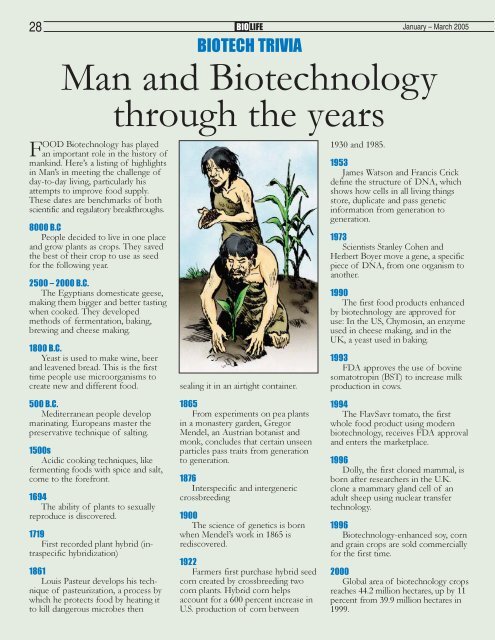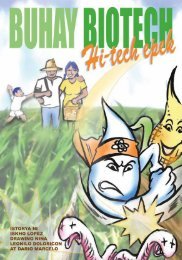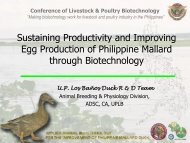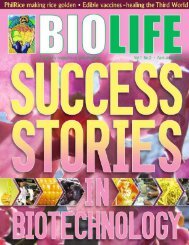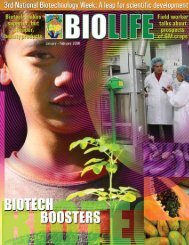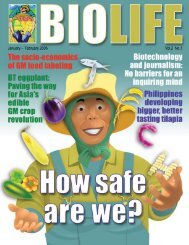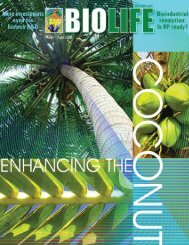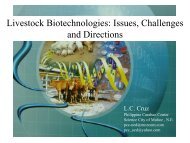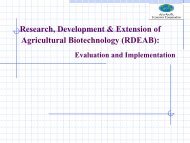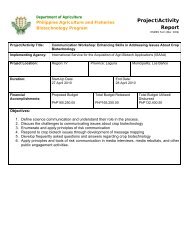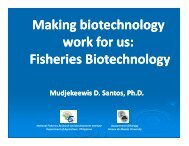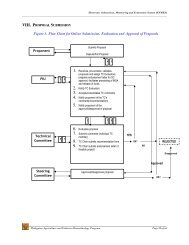Download PDF - SEARCA Biotechnology Information Center
Download PDF - SEARCA Biotechnology Information Center
Download PDF - SEARCA Biotechnology Information Center
Create successful ePaper yourself
Turn your PDF publications into a flip-book with our unique Google optimized e-Paper software.
28 BIO LIFE January – March 2005<br />
FOOD <strong>Biotechnology</strong> has played<br />
an important role in the history of<br />
mankind. Here’s a listing of highlights<br />
in Man’s in meeting the challenge of<br />
day-to-day living, particularly his<br />
attempts to improve food supply.<br />
These dates are benchmarks of both<br />
scientific and regulatory breakthroughs.<br />
8000 B.C<br />
People decided to live in one place<br />
and grow plants as crops. They saved<br />
the best of their crop to use as seed<br />
for the following year.<br />
2500 – 2000 B.C.<br />
The Egyptians domesticate geese,<br />
making them bigger and better tasting<br />
when cooked. They developed<br />
methods of fermentation, baking,<br />
brewing and cheese making.<br />
1800 B.C.<br />
Yeast is used to make wine, beer<br />
and leavened bread. This is the first<br />
time people use microorganisms to<br />
create new and different food.<br />
BIOTECH TRIVIA<br />
Man and <strong>Biotechnology</strong><br />
through the years<br />
sealing it in an airtight container.<br />
1930 and 1985.<br />
1953<br />
James Watson and Francis Crick<br />
define the structure of DNA, which<br />
shows how cells in all living things<br />
store, duplicate and pass genetic<br />
information from generation to<br />
generation.<br />
1973<br />
Scientists Stanley Cohen and<br />
Herbert Boyer move a gene, a specific<br />
piece of DNA, from one organism to<br />
another.<br />
1990<br />
The first food products enhanced<br />
by biotechnology are approved for<br />
use: In the US, Chymosin, an enzyme<br />
used in cheese making, and in the<br />
UK, a yeast used in baking.<br />
1993<br />
FDA approves the use of bovine<br />
somatotropin (BST) to increase milk<br />
production in cows.<br />
500 B.C.<br />
Mediterranean people develop<br />
marinating. Europeans master the<br />
preservative technique of salting.<br />
1500s<br />
Acidic cooking techniques, like<br />
fermenting foods with spice and salt,<br />
come to the forefront.<br />
1694<br />
The ability of plants to sexually<br />
reproduce is discovered.<br />
1719<br />
First recorded plant hybrid (intraspecific<br />
hybridization)<br />
1861<br />
Louis Pasteur develops his technique<br />
of pasteurization, a process by<br />
which he protects food by heating it<br />
to kill dangerous microbes then<br />
1865<br />
From experiments on pea plants<br />
in a monastery garden, Gregor<br />
Mendel, an Austrian botanist and<br />
monk, concludes that certain unseen<br />
particles pass traits from generation<br />
to generation.<br />
1876<br />
Interspecific and intergeneric<br />
crossbreeding<br />
1900<br />
The science of genetics is born<br />
when Mendel’s work in 1865 is<br />
rediscovered.<br />
1922<br />
Farmers first purchase hybrid seed<br />
corn created by crossbreeding two<br />
corn plants. Hybrid corn helps<br />
account for a 600 percent increase in<br />
U.S. production of corn between<br />
1994<br />
The FlavSavr tomato, the first<br />
whole food product using modern<br />
biotechnology, receives FDA approval<br />
and enters the marketplace.<br />
1996<br />
Dolly, the first cloned mammal, is<br />
born after researchers in the U.K.<br />
clone a mammary gland cell of an<br />
adult sheep using nuclear transfer<br />
technology.<br />
1996<br />
<strong>Biotechnology</strong>-enhanced soy, corn<br />
and grain crops are sold commercially<br />
for the first time.<br />
2000<br />
Global area of biotechnology crops<br />
reaches 44.2 million hectares, up by 11<br />
percent from 39.9 million hectares in<br />
1999.


